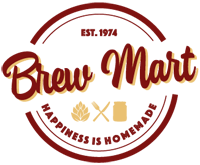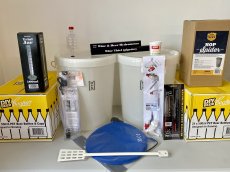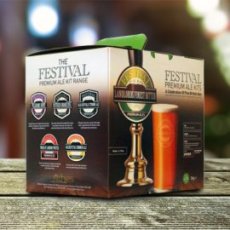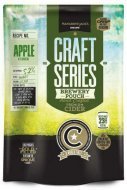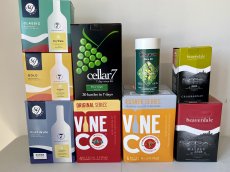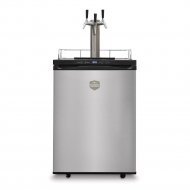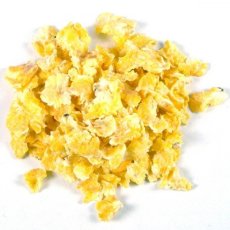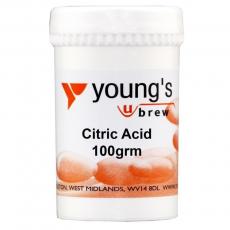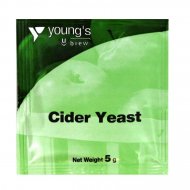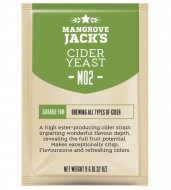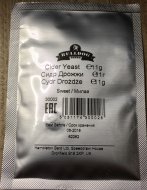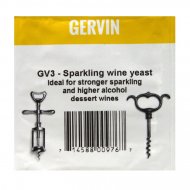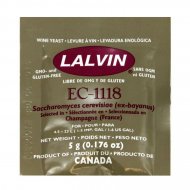Sign up to the Brew Mart newsletter for the latest news, offers & more
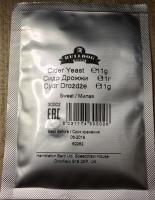
Cider Yeast
Buy the best homebrew cider yeast for all the different types of cider making from Brew Mart Sheffield.
The different types of cider making are hard, sparkling, sweet, dry, apple or any fruit, champagne and beer to name a few.
The term hard cider is used to differentiate cider making which, has been fermented and is an alcoholic drink instead of fruit that has just been pressed and is pure fruit juice. By yeasts very nature, all yeasts start fermentation, which creates an alcoholic beverage, and in this category, it can be called hard cider.
Yeast selection for cider
Before you start, it is advisable to take some time to think about your yeast choice for making the best hard (alcoholic) cider. Cider objectives can be simple to complex.
All cider is Sparkling. However, some can be more sparkling than others, and this is achieved by using a yeast for sparkling cider making, such as GV3 or EC1118 or Young's dry cider yeast. The latter two contain a bayanus yeast strain which is particularly good for an apple cider making yeast.
We then have a choice depending on your tastes of sweet or dry cider yeast. Both of them are fine, and you can not say which is the better yeast for sweet or dry cider making as it all comes down to individual taste in the end.
A good choice is Champagne yeast strand of white wine yeast to brew hard cider due to its vigorous agent that also preserves the apple flavours of your cider.
There are cider-specific yeasts from commercial yeast producers and a whole world of yeast strains originally selected for beer or wine that can also apply to cider making.
Let's explore some variables that go into choosing a yeast strain for cider making and then a range of specific alternatives.
- Decide what your specific objectives for your particular cider are.
- The type of apples or juice that you will have available for the project also influences the choice of yeast.
- You may have a large glut of apples or other fruit and wish to turn them into a clean, straightforward cider as quickly and simply as possible.
- You may be interested in the history of cider and would like to re-create a historical category or style of hard (alcoholic) cider.
- The character of the apples needs consideration, such as the number of tannins they contain.
- Are you seeking to express specific fruit characteristics or capture the features of the apples in one particular orchard or region?
- Another consideration is choosing a yeast that contributes to an exotic profile in the finished cider.
- Even after all these decisions, you still can choose many yeast strains with many effects.
- Lastly, you can rely on indigenous yeast and wait and see how your cider turns out. However, that is not a yeast choice that you will have control over during fermentation.
STRAIN CONSIDERATIONS
There are three broad attributes of yeast strains for fermentation to make a yeast choice to match your apples and your objectives.
- Many yeasts might be described as "clean" or "neutral" in their effects, producing little in the way of added estery aromas or yeast-derived flavours.
- Others are targeted explicitly at aromatic enhancement, often developing fruity esters reminiscent of apples and pears.
- Finally, speciality yeasts, mostly borrowed from beer brewing practice, introduce dramatically different aromas such as the barnyard funk of Brettanomyces or the bananas -and cloves of a German hefeweizen.
NEUTRAL
EC1118 from Lallemand: This is a traditional choice among the Champagne-style yeasts. This yeast contains a bayanus strain of Saccharomyces and has a high alcohol tolerance of about 18%.
A high alcohol tolerance level would not likely come naturally from apples themselves. However, if you add sugar to make apple wine, this yeast would be a good neutral choice. The character of the apples would come to the forefront. The finished cider is usually bone-dry with no hint of sweetness.
CIDER SPECIFIC YEAST
Commercial yeast producers have noticed the popularity of cider brewing and now make cider-specific strains.
Mangrove Jack's Cider Yeast M02 is one example of a yeast explicitly produced for cider brewing. This cider yeast has "aromatic" strains, produces fresh fruity esters, and has a lingering finish.
Safcider from Fermentis: This cider yeast is another bayanus strain that is effective at fermenting cider even under challenging conditions. Safcider has a wide fermentation temperature tolerance of 50 to 86 °F (10 to 30 °C).
BEER YEAST FOR CIDER
What about using a beer or ale yeast when home brewing cider?
Cider is a fermentation process, whereas beer is a brewing process. However, a novelty that seems to come from America is to use beer yeast such as Nottingham Ale Yeast when fermenting your cider, and this produces a clean, crisp finish to your cider.
In this section of yeast strains, you will find a division between fairly neutral/somewhat fruity yeasts in lager and ale strains compared with very character-driven speciality yeast strains for specific exotic effects. Many beer yeasts are not as alcohol tolerant as wine yeasts, but they bring a wide range of aromatic characters.
You may experiment with other types, such as mead yeast.
NEUTRAL/FRUITY
Saflager S-23 from Fermentis: This dry lager yeast was derived originally from the VLB-Berlin German brewery. Saflager produces fruity and estery lager beers in its primary role and can bring similar effects to ciders. However, it may subdue it compared with fruity wine or fruity cider yeasts. As with lager fermentation, you should ferment it between 53 and 59 °F (12 and 15 °C). Saflager has a lower attenuation profile than some other lager yeasts and may leave slight residual sweetness.
Adding yeast to your juice is an important step, as it starts the fermentation process. The yeast consumes the sugars present in your liquid and transforms them into alcohol. The more sugar your brew has initially, the higher the alcohol content.
SOME TIPS FOR SUCCESS
- If your initial attempt at cider tastes flat, add one teaspoon of tannin per 5 gallons (19 L)
- You may also raise the total acidity, as needed, with a small amount of tartaric acid.
- To raise the cider's alcohol level, add sugar before fermentation to increase the sugar content to 17–18 °Brix (1.070–1.074 SG), an average grade for traditional New England-style ciders.
- You may use small amounts of brown sugar or molasses for part of the sugar.
